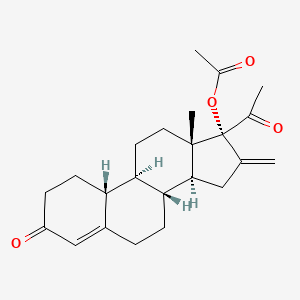



1. 16-methylene-17alpha-acetoxy-19-nor-4-pregnen-3,20-dione
2. St 1435
3. St-1435
1. Nestoron
2. 7759-35-5
3. Elcometrine
4. Segesterone Acetate
5. St-1435
6. Segesterone Acetate [usan]
7. 17-hydroxy-16-methylene-19-norpregn-4-ene-3,20-dione Acetate
8. 9amx4q13cc
9. 16-methylene-17-alpha-acetoxy-19-nor-4-pregnene-3,20-dione
10. 19-norpregn-4-ene-3,20-dione, 17-(acetyloxy)-16-methylene-
11. Segesterone Acetate (usan)
12. St 1435
13. (8r,9s,10r,13s,14s,17r)-17-acetyl-13-methyl-16-methylene-3-oxo-2,3,6,7,8,9,10,11,12,13,14,15,16,17-tetradecahydro-1h-cyclopenta[a]phenanthren-17-yl Acetate
14. Unii-9amx4q13cc
15. Segesterone-acetate
16. Nestorone (tn)
17. [(8r,9s,10r,13s,14s,17r)-17-acetyl-13-methyl-16-methylidene-3-oxo-2,6,7,8,9,10,11,12,14,15-decahydro-1h-cyclopenta[a]phenanthren-17-yl] Acetate
18. 16-methylene-17alpha-acetoxy-19-nor-4-pregnen-3,20-dione
19. Elcometrine [mi]
20. Schembl1261001
21. Chembl3707377
22. Elcometrine;nestorone;st-1435
23. Nestorone, >=97% (hplc)
24. Dtxsid70998804
25. Chebi:135563
26. 16-methylene-17-hydroxy-19-norpregn-4-ene-3,20-dione Acetate
27. Bcp12737
28. Zinc5167230
29. 19-norpregn-4-ene-3,20-dione, 17-hydroxy-16-methylene-, Acetate
30. Segesterone Acetate [who-dd]
31. Akos025402243
32. Ac-6844
33. Cs-0411
34. Db14583
35. Ncgc00487114-02
36. Segesterone Acetate [orange Book]
37. Hy-13071
38. Annovera Component Segesterone Acetate
39. D10986
40. E89278
41. Segesterone Acetate Component Of Annovera
42. 759n355
43. A914499
44. Elcometrine;nestorone;st-1435;st 1435;st1435
45. Q1978481
46. 1-tert-butoxycarbonylamino-cyclopent-3-enecarboxylicacid
47. 16-methylene-17.alpha.-acetoxy-19-nor-pregn-4-ene-3,20-dione
48. 17-(acetyoxy)-16- Methylene -19-nonpregn-4-ene-3,20-dione
| Molecular Weight | 370.5 g/mol |
|---|---|
| Molecular Formula | C23H30O4 |
| XLogP3 | 2.9 |
| Hydrogen Bond Donor Count | 0 |
| Hydrogen Bond Acceptor Count | 4 |
| Rotatable Bond Count | 3 |
| Exact Mass | 370.21440943 g/mol |
| Monoisotopic Mass | 370.21440943 g/mol |
| Topological Polar Surface Area | 60.4 Ų |
| Heavy Atom Count | 27 |
| Formal Charge | 0 |
| Complexity | 762 |
| Isotope Atom Count | 0 |
| Defined Atom Stereocenter Count | 6 |
| Undefined Atom Stereocenter Count | 0 |
| Defined Bond Stereocenter Count | 0 |
| Undefined Bond Stereocenter Count | 0 |
| Covalently Bonded Unit Count | 1 |
Segesterone acetate in combination with ethinyl estradiol is indicated for use by females of reproductive potential to prevent pregnancy as a combination hormonal contraceptive (CHC). It induces contraception for thirteen 28-day cycles (1 year) following vaginal administration. The vaginal system must remain in place continuously for 3 weeks (21 days) followed by a 1-week (7-day) vaginal system-free interval. The use in females with a body mass index of >29 kg/m^2 has not been adequately evaluated.
FDA Label
Segesterone acetate suppresses ovulation. In a Phase I randomized, placebo-controlled, randomized crossover study involving healthy adult female subjects, there was no clinically significant QTc interval prolongation following a single intravenous bolus dose of segesterone acetate. Segesterone acetate shows no androgenic, anabolic, or estrogenic activity. It also did not show uterotropic activity in ovariectomized rats. In the endometrial transformation test to assess the progestational activity, dose-dependent increases in both uterine weight was observed following subcutaneous administration of segesterone acetate.
Contraceptive Agents, Female
Chemical substances or agents with contraceptive activity in females. Use for female contraceptive agents in general or for which there is no specific heading. (See all compounds classified as Contraceptive Agents, Female.)
Contraceptive Agents, Hormonal
Contraceptive agents that act on the ENDOCRINE SYSTEM. (See all compounds classified as Contraceptive Agents, Hormonal.)
Absorption
Contraceptive vaginal rings provided sustained release of contraceptive levels of segesterone acetate over 90 days in a pharmacokinetic study of healthy women. Following vaginal administration for up to 13 cycles, segesterone acetate was absorbed into systemic administration and reached the peak plasma concentration in 2 hours in Cycle 1, Cycle 3, and Cycle 13. Concentrations declined after time to reach plasma concentration (Tmax) and became more constant after 96 hours post-dose.Over subsequent cycles of use, the peak serum concentrations of segesterone acetate decreased. In Cycle 1, 3 and 13, the peak plasma concentrations were 1147, 363, and 294 pg/mL.
Route of Elimination
In a pharmacokinetic study, approximately 81.4% and 7.62% of the subcutaneously-administered dose in rats was excreted via feces and urine, respectively.
Volume of Distribution
The volume of distribution of segesterone acetate is 19.6 L/kg.
Clearance
No pharmacokinetic data available.
Segesterone acetate undergoes rapid metabolism and inactivation in the liver. Based on the findings _in vitro_, the major oxidative metabolites in the serum include 5-dihydro- and 17-hydroxy-5-dihydro metabolites constitute about 50% of exposure relative to segesterone acetate. The metabolites are not pharmacologically active with EC50 to progesterone receptor 10-fold higher than that of the parent compound. It was shown that 3, 5-tetrahydrosegesterone acetate acts as an activator at the GABA-A receptors in the brain.
The mean (SD) half life of segesterone acetate is 4.5 (3.4) hours.
Segesterone acetate selectively binds to the progesterone receptor (PR), a transcription factor belonging to the nuclear receptor superfamily, where it acts as an agonist and transactivator. According to the findings from docking experiments, it adopts the same docking position within the PR ligand-binding domain (LBD) as progesterone but due to additional stabilizing contacts between 17-acetoxy and 16-methylene groups and PR LBD, segesterone acetate display higher potency than progesterone. As with other progestins, segesterone acetate prevents ovulation by blocking the midcycle surge in luteinizing hormone (LH) secretion, thereby inhibiting the development of ovarian follicles. When used in combination with segesterone acetate, ethinyl estradiol potentiates the antigonadotropic of the progestin and prevents irregular shedding of the endometrium. Segesterone acetate lacks androgenic activity, and displayed binding affinity to androgen receptors that was 500- to 600-fold less than that of testosterone. It does not display binding affinity toward estrogen receptors. When the relative binding affinities of segesterone acetate to human steroid receptors were investigated _in vitro_, it was demonstrated that segesterone acetate binds to the glucocorticoid receptor. However, segesterone acetate did not exert any glucocorticoid activity in the _in vivo_ assays showing no increase in liver glycogen and tyrosine transaminase TAT.
